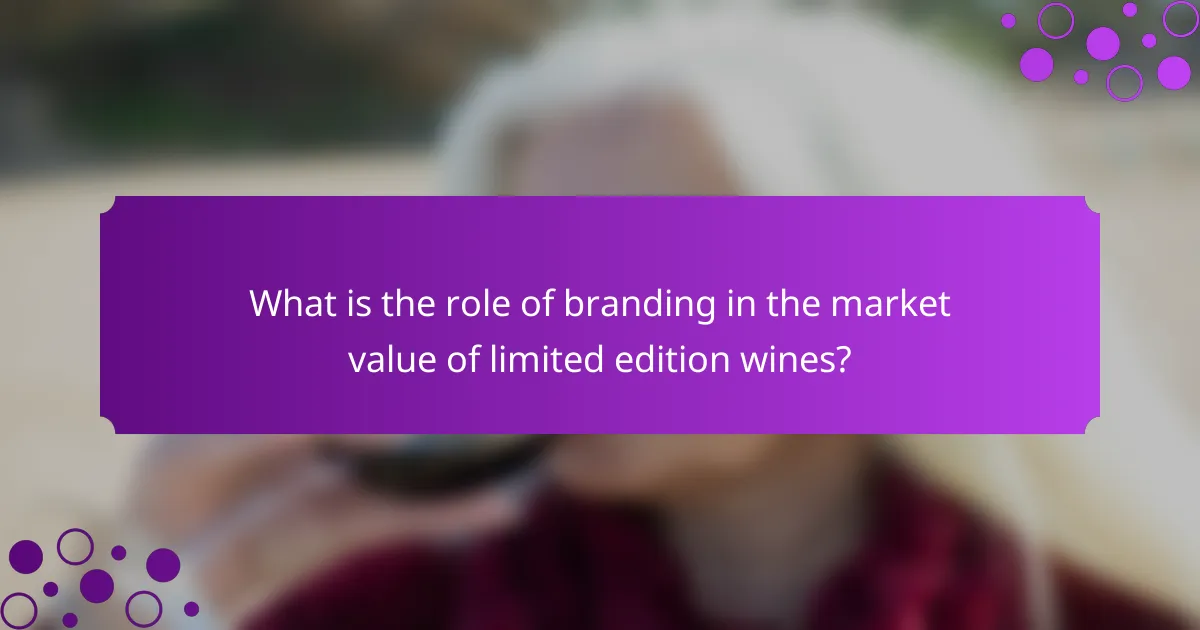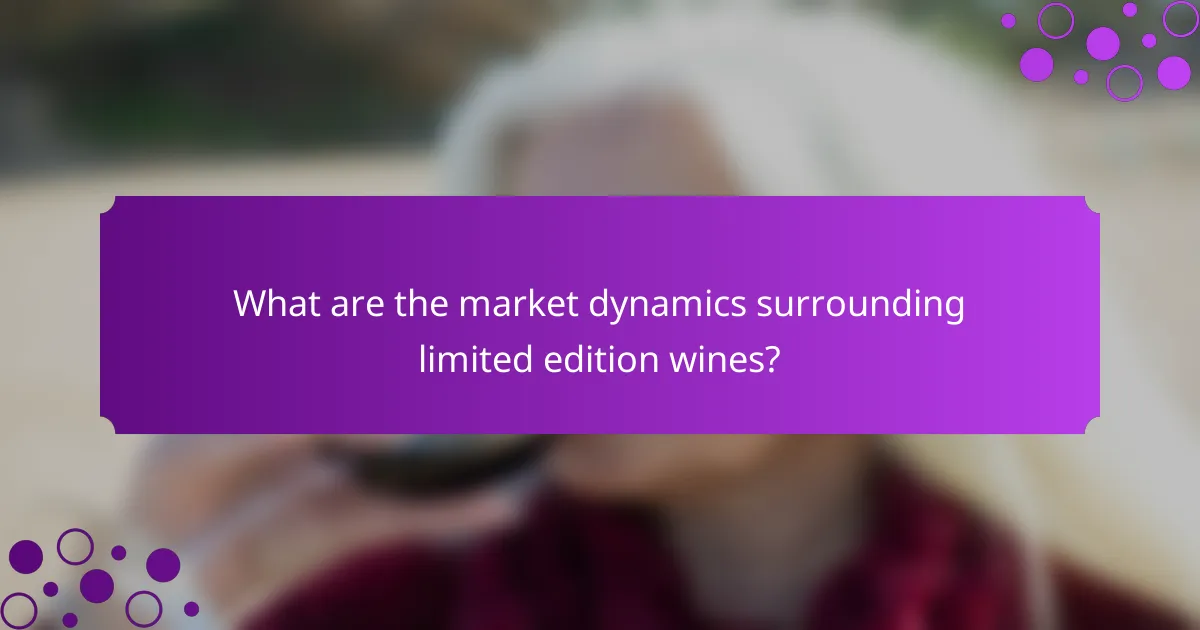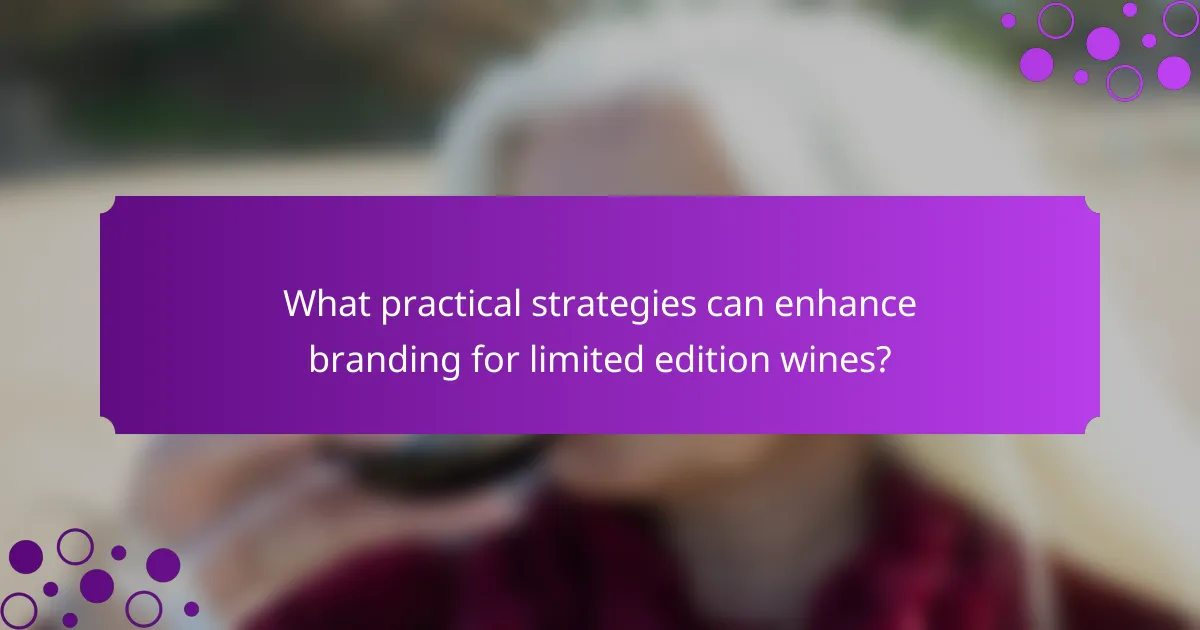
What is the role of branding in the market value of limited edition wines?
Branding significantly enhances the market value of limited edition wines. Strong branding creates a perception of exclusivity and quality. This perception drives consumer demand and willingness to pay higher prices. Limited edition wines often have unique branding elements that differentiate them from regular offerings. These elements include distinctive labels, storytelling, and heritage. According to a study by Wine Intelligence, consumers are willing to pay 20-30% more for wines with strong brand recognition. Additionally, branding influences the overall buying experience, making it more appealing. This emotional connection to the brand further increases market value.
How does branding influence consumer perception of limited edition wines?
Branding significantly influences consumer perception of limited edition wines. Strong branding creates an image of exclusivity and quality. Consumers often associate well-known brands with superior taste and craftsmanship. This perception can lead to a willingness to pay higher prices. Research shows that branded wines are perceived as more desirable. A study by the University of California found that branding affects consumer choices in wine purchasing. Limited edition labels enhance perceived value through scarcity and uniqueness. Effective branding strategies can increase market demand for these wines.
What are the key elements of branding that affect market value?
The key elements of branding that affect market value include brand identity, brand equity, and brand loyalty. Brand identity encompasses the visual elements and messaging that distinguish a brand. This includes logos, packaging, and design. Strong brand identity can lead to higher consumer recognition and trust, influencing purchasing decisions.
Brand equity refers to the value added to a product due to its brand name. Research shows that brands with high equity can command premium prices. For instance, luxury brands often achieve higher market value due to their established reputation.
Brand loyalty is the commitment of consumers to repurchase or continue using a brand. Loyal customers tend to be less price-sensitive and more likely to recommend the brand to others. Studies indicate that brands with strong loyalty can maintain market value even during economic downturns.
Together, these elements create a robust branding strategy that can significantly enhance the market value of products, including limited edition wines.
How do brand stories enhance the appeal of limited edition wines?
Brand stories enhance the appeal of limited edition wines by creating emotional connections with consumers. These narratives provide context and background, making the wine feel more exclusive and valuable. A compelling brand story can evoke nostalgia, heritage, or craftsmanship. For example, a winery may share its century-old traditions or the unique terroir of its vineyards. This connection can increase perceived value and desirability. Research shows that consumers are willing to pay more for products with a strong narrative. This emotional engagement often leads to higher sales and loyalty. Thus, brand stories play a crucial role in differentiating limited edition wines in a competitive market.
Why is branding essential for the market value of limited edition wines?
Branding is essential for the market value of limited edition wines because it creates recognition and desirability. Strong branding differentiates a wine from competitors. It communicates quality, heritage, and exclusivity. This perceived value can significantly increase consumer willingness to pay. For example, wines with established brands often sell for higher prices than unbranded counterparts. According to a study by the Journal of Wine Economics, branded wines can command prices up to 30% higher. Effective branding also fosters customer loyalty and repeat purchases. In the competitive wine market, strong branding is crucial for maintaining and enhancing market value.
What role does brand recognition play in pricing strategies?
Brand recognition significantly influences pricing strategies. Brands with high recognition can command premium prices. Consumers often associate well-known brands with higher quality. This perception allows brands to maintain margins above competitors. For instance, luxury wine brands can price their limited editions higher due to established prestige. Research shows that brand equity contributes to consumer willingness to pay more. A study by Aaker (1991) highlights that strong brand recognition enhances customer loyalty. Loyalty leads to repeat purchases, reinforcing higher price points. Thus, brand recognition directly affects pricing strategy effectiveness.
How does branding impact the perceived quality of limited edition wines?
Branding significantly influences the perceived quality of limited edition wines. A strong brand creates an image of exclusivity and prestige. This perception elevates consumer expectations regarding taste and quality. Research shows that consumers often associate well-known brands with higher quality, regardless of the actual product characteristics. For instance, a study published in the Journal of Wine Economics found that branding can increase a wine’s perceived value by up to 30%. Limited edition wines often leverage unique branding strategies to enhance desirability. These strategies include storytelling, heritage, and visual aesthetics. Ultimately, effective branding shapes consumer perceptions and drives purchase decisions in the limited edition wine market.
How do different branding strategies affect limited edition wines?
Different branding strategies significantly influence the market perception and value of limited edition wines. Premium branding enhances exclusivity and desirability, often leading to higher sales prices. For example, brands like Opus One utilize luxury branding to create a high-status image. This strategy attracts affluent consumers willing to pay a premium.
Conversely, value branding may emphasize affordability and accessibility. This approach can lead to increased volume sales but may dilute the perceived exclusivity. Research shows that limited edition wines marketed as luxury items can see price increases of up to 30% compared to standard offerings.
Additionally, storytelling in branding can enhance emotional connections with consumers. Brands that share their heritage or unique production methods often achieve stronger market positioning. Overall, branding strategies directly impact consumer perception, pricing, and sales performance of limited edition wines.
What types of branding strategies are most effective for limited edition wines?
Effective branding strategies for limited edition wines include exclusivity, storytelling, and sensory marketing. Exclusivity creates a sense of urgency and desirability. Brands often limit production to enhance this perception. Storytelling connects consumers emotionally to the wine’s heritage or the winemaker’s journey. This approach can increase perceived value. Sensory marketing engages customers through taste, smell, and visual appeal. For instance, unique bottle designs can attract attention. Research shows that limited edition products can command higher prices due to these strategies. A study by the Journal of Wine Economics indicates that branding significantly influences consumer purchasing decisions in the wine market.
How do collaborations with artists or designers enhance brand value?
Collaborations with artists or designers enhance brand value by creating unique, visually appealing products. These partnerships can attract new consumer segments who appreciate art and design. They also generate buzz and media coverage, increasing brand visibility. Limited edition releases often command higher prices due to their exclusivity. According to a study by the Journal of Marketing Research, brands that collaborate with well-known artists see a 20% increase in consumer interest. This heightened interest can lead to increased sales and customer loyalty. Overall, such collaborations elevate the perceived value of the brand and its products.

What are the market dynamics surrounding limited edition wines?
Limited edition wines experience unique market dynamics influenced by scarcity and branding. The limited availability creates a perception of exclusivity among consumers. This exclusivity often drives higher demand, leading to increased market prices. Brands leverage storytelling and heritage to enhance their appeal. Consumer interest is further fueled by the association of limited editions with special occasions. Market trends show that collectors are willing to pay premium prices for these wines. Additionally, social media plays a significant role in promoting limited edition releases. Successful marketing strategies often include collaborations with renowned chefs or events to boost visibility.
How does scarcity influence the branding of limited edition wines?
Scarcity significantly enhances the branding of limited edition wines. It creates a perception of exclusivity and desirability. Limited availability drives consumer demand. This phenomenon is supported by the principles of supply and demand in economics. When fewer bottles are available, consumers are more likely to view them as valuable. A study by the Journal of Wine Economics indicates that limited edition wines often command higher prices. Scarcity can also lead to increased brand loyalty among consumers. Customers are more inclined to invest in brands that offer unique, hard-to-find products. Ultimately, scarcity serves as a powerful marketing tool in the wine industry.
What psychological factors drive consumers to purchase limited edition wines?
Consumers are driven to purchase limited edition wines by factors such as scarcity, exclusivity, and social status. Scarcity creates a sense of urgency, making consumers feel they must act quickly. Exclusivity appeals to the desire for unique experiences and ownership of something rare. Social status is enhanced through the possession of limited edition wines, signaling wealth and sophistication to peers. According to a study published in the Journal of Consumer Research, consumers often associate limited editions with higher quality. This perception further motivates purchases. Additionally, emotional connections to brands can influence buying behavior. Consumers may feel a stronger attachment to brands that offer limited editions, enhancing brand loyalty.
How does market demand fluctuate for limited edition wines?
Market demand for limited edition wines fluctuates based on exclusivity and consumer interest. Limited editions create a sense of scarcity, driving up demand. When a brand releases a limited edition wine, collectors and enthusiasts often respond positively. This initial excitement can lead to increased sales and higher prices. Demand may spike during promotional events or wine shows. Conversely, if the wine does not meet quality expectations, demand can drop. Historical trends show that successful limited editions often see resale values increase over time. For example, certain vintages from renowned wineries have appreciated significantly in the secondary market. Additionally, market demand can be influenced by branding efforts and marketing strategies.
What are the challenges faced in branding limited edition wines?
Branding limited edition wines faces several challenges. One significant challenge is market differentiation. Limited edition wines must stand out in a crowded marketplace. Competing brands often produce similar products, making it hard to establish a unique identity.
Another challenge is consumer perception. Consumers may associate limited editions with higher prices, which can deter some buyers. Additionally, the exclusivity of limited editions can create a perception of elitism, alienating potential customers.
Distribution is also a challenge for branding. Limited availability can restrict reach and impact brand visibility. This limited distribution can hinder brand recognition and consumer engagement.
Finally, maintaining quality is crucial. Limited edition wines must meet high standards to justify their branding. Any inconsistency in quality can damage the brand’s reputation.
These challenges require strategic branding efforts to effectively communicate value and build a loyal customer base.
How can brands effectively communicate exclusivity without alienating consumers?
Brands can effectively communicate exclusivity by creating limited availability and unique experiences. This approach fosters a sense of urgency among consumers. For example, brands can release limited edition products that highlight craftsmanship. They can also offer exclusive access to events for loyal customers. These strategies build a community around the brand without excluding others. Research shows that brands like Rolex maintain exclusivity while appealing to a broader audience. This balance enhances brand value and consumer loyalty.
What risks are associated with over-branding limited edition wines?
Over-branding limited edition wines can dilute their perceived exclusivity. This dilution may lead to reduced consumer interest. When a brand is overly promoted, it can create a sense of saturation. Consumers may begin to view the product as less special. The uniqueness that drives demand can be compromised. Additionally, over-branding can alienate loyal customers. They may feel that the brand has lost its authenticity. Historical data indicates that brands that maintain a balance in marketing often retain higher market value. Excessive branding may also trigger negative consumer perceptions. This can ultimately affect sales and brand loyalty.

What practical strategies can enhance branding for limited edition wines?
Creating a strong brand for limited edition wines involves several practical strategies. First, storytelling is essential. Crafting a compelling narrative around the wine’s origin, production process, or the winemaker’s vision can create emotional connections with consumers. Second, unique packaging can enhance appeal. Distinctive bottle designs or labels can make the wine stand out on shelves. Third, exclusivity should be emphasized. Limited availability can increase desirability, making consumers feel they are part of an elite group. Fourth, leveraging social media is crucial. Engaging content and targeted advertising can reach a wider audience effectively. Fifth, collaborations with influencers can boost visibility. Influencers can introduce the wine to their followers, enhancing brand recognition. Lastly, hosting tasting events can create immersive experiences. These events allow consumers to connect directly with the brand and product. Each of these strategies can significantly enhance the branding of limited edition wines.
How can wineries effectively leverage social media for branding?
Wineries can effectively leverage social media for branding by creating engaging content that showcases their unique offerings. They should focus on high-quality visuals of their wines, vineyards, and tasting experiences. Regular posts that tell the story behind each wine can build an emotional connection with consumers. Collaborating with influencers in the wine industry can also expand their reach and credibility. Engaging with followers through comments and direct messages fosters community and loyalty. Utilizing targeted ads can help wineries reach specific demographics interested in premium wines. Analytics tools can track engagement and inform strategies for future campaigns. According to a study by the Wine Market Council, 45% of wine consumers use social media to learn about new wines, highlighting its importance in branding.
What content strategies can engage consumers and elevate brand perception?
Effective content strategies that engage consumers and elevate brand perception include storytelling, user-generated content, and educational materials. Storytelling creates emotional connections with consumers, enhancing brand loyalty. User-generated content fosters community and trust, as consumers see real experiences shared by others. Educational materials provide valuable information, positioning the brand as an authority in the industry.
Research shows that brands using storytelling can increase engagement by up to 300%. Brands that leverage user-generated content see a 79% increase in consumer trust. Additionally, educational content can improve brand perception by 70%, as consumers appreciate brands that provide insights and knowledge.
These strategies not only engage consumers but also enhance the overall perception of the brand in the market.
How do tasting events and experiences contribute to brand loyalty?
Tasting events and experiences foster brand loyalty by creating direct engagement between consumers and brands. These events allow consumers to interact with products in a memorable way. Engaging sensory experiences enhance emotional connections to the brand. Research shows that 70% of consumers are more likely to purchase a product after a positive tasting experience. Additionally, personal interactions with brand representatives build trust and credibility. Tasting events also create a sense of community among consumers, encouraging repeat purchases. This communal aspect reinforces brand identity and loyalty. Overall, tasting experiences significantly influence consumer perceptions and brand attachment.
What best practices should wineries follow for successful branding?
Wineries should establish a strong brand identity to achieve successful branding. This includes creating a unique logo and consistent color scheme. Storytelling is essential; wineries should share their history and values. Engaging with customers through social media can enhance brand loyalty. Offering high-quality products reinforces brand reputation. Collaborations with local businesses can expand reach and visibility. Participating in wine competitions can validate quality and attract attention. Finally, maintaining excellent customer service fosters positive relationships and encourages repeat business.
How can wineries measure the effectiveness of their branding efforts?
Wineries can measure the effectiveness of their branding efforts through various metrics. These include brand awareness surveys, customer feedback, and sales data. Brand awareness surveys assess recognition and recall among target demographics. Customer feedback provides insights into perceptions and experiences with the brand. Sales data can indicate shifts in consumer purchasing behavior linked to branding initiatives. Additionally, social media engagement metrics reflect consumer interactions with the brand online. Tracking these metrics over time allows wineries to evaluate changes in brand perception and market position. Research shows that effective branding can lead to increased customer loyalty and higher sales. For instance, a study by the Wine Market Council found that consumers are willing to pay more for wines from brands they recognize and trust.
What common mistakes should wineries avoid in their branding strategies?
Wineries should avoid inconsistency in branding across all platforms. This mistake can confuse consumers and dilute brand identity. Additionally, neglecting to understand the target audience can lead to ineffective messaging. Wineries must ensure their branding resonates with their desired customer base. Failure to create a strong visual identity can also hinder recognition. A compelling logo and cohesive design are essential for brand recall. Ignoring the importance of storytelling can diminish emotional connections with consumers. Wineries should craft narratives that highlight their unique qualities. Lastly, overlooking digital presence can limit market reach. A robust online strategy is crucial in today’s marketplace.
The main entity of the article is branding in the context of limited edition wines. The article explores how branding enhances the market value of these wines by creating perceptions of exclusivity and quality, driving consumer demand, and justifying higher prices. Key elements discussed include brand identity, equity, loyalty, and the impact of storytelling on consumer perception. Additionally, it addresses the challenges of branding, effective strategies for enhancing brand value, and the importance of measuring branding effectiveness in the competitive wine market.